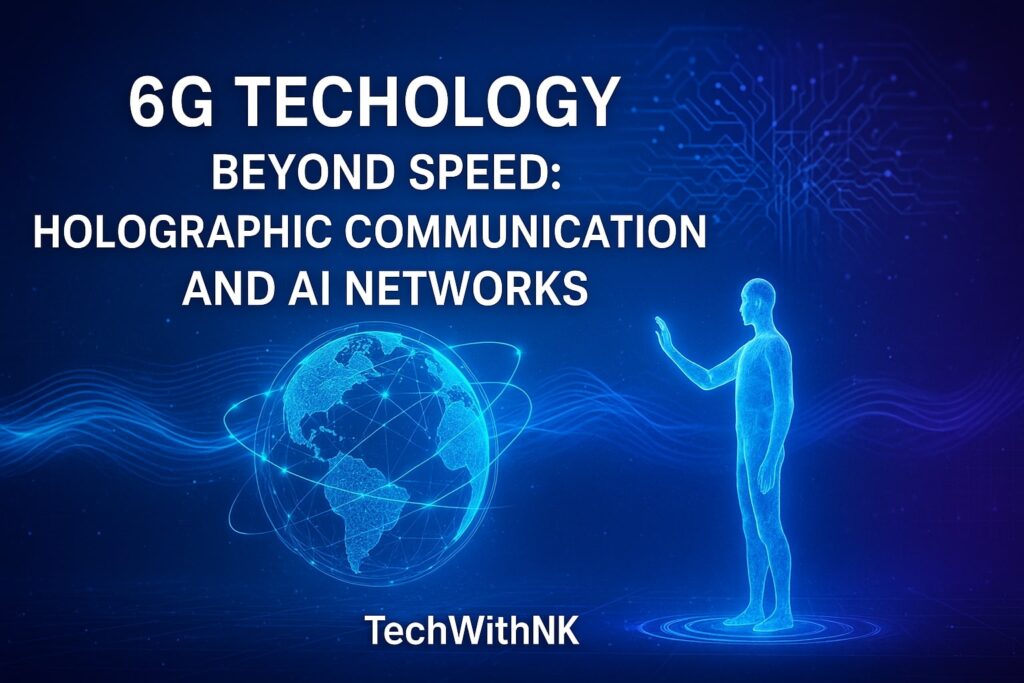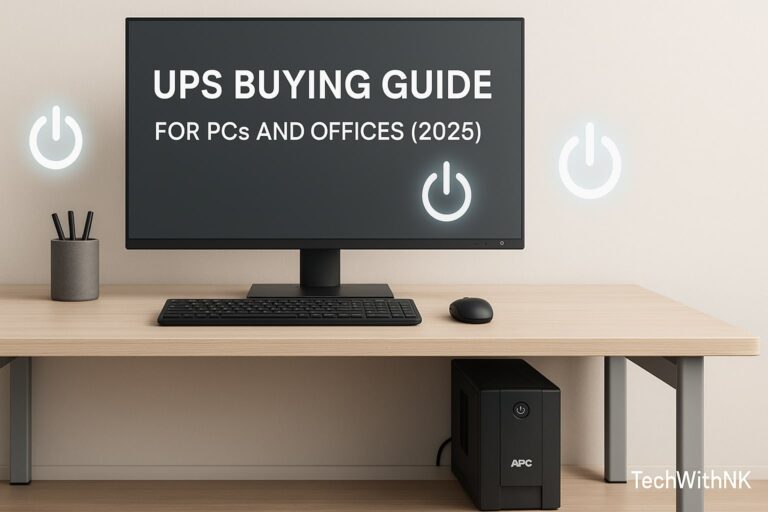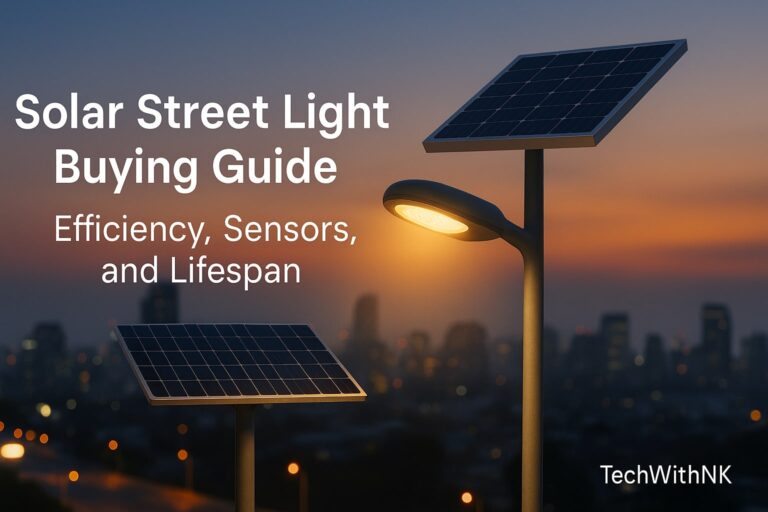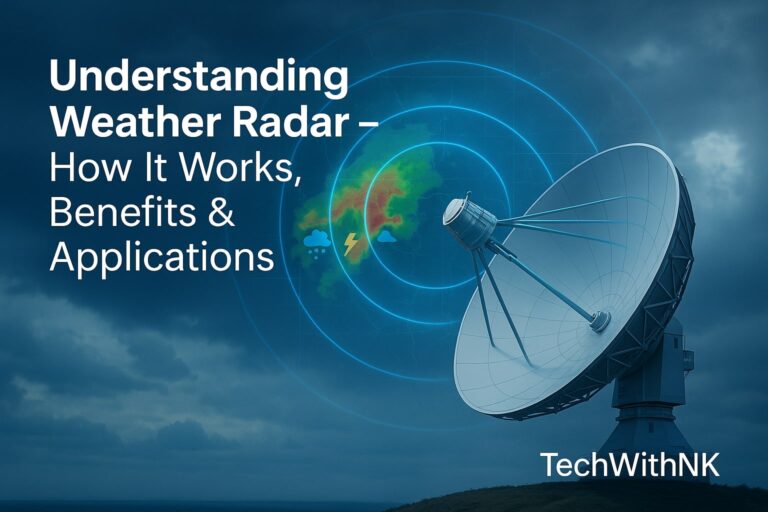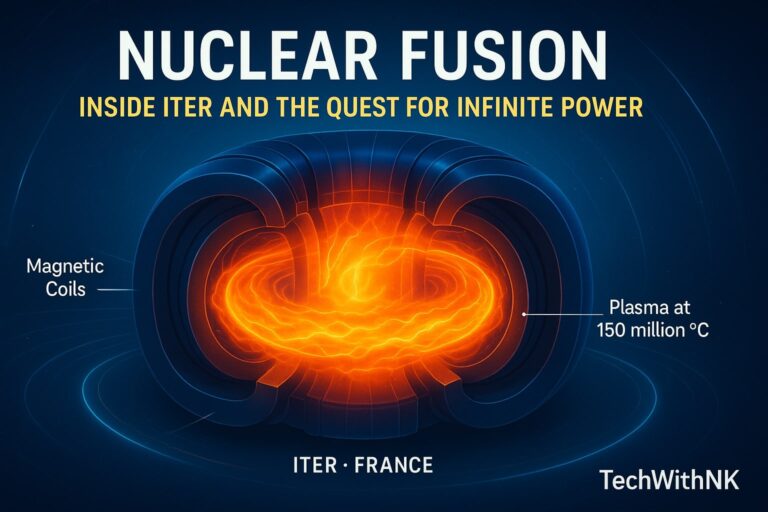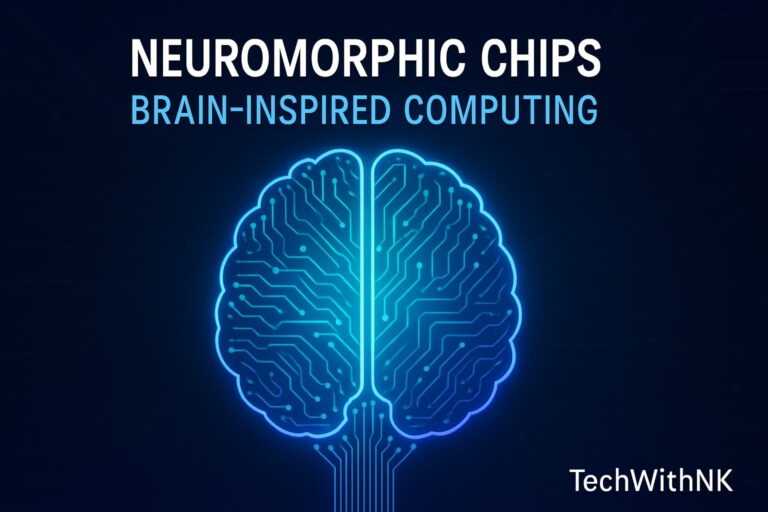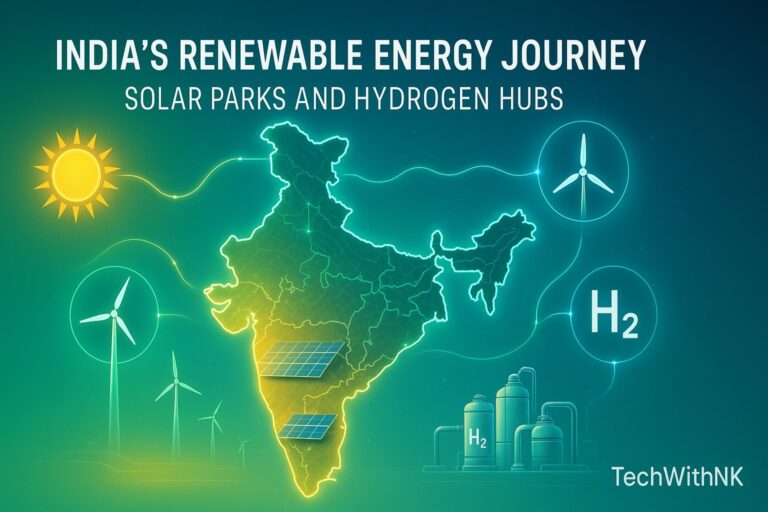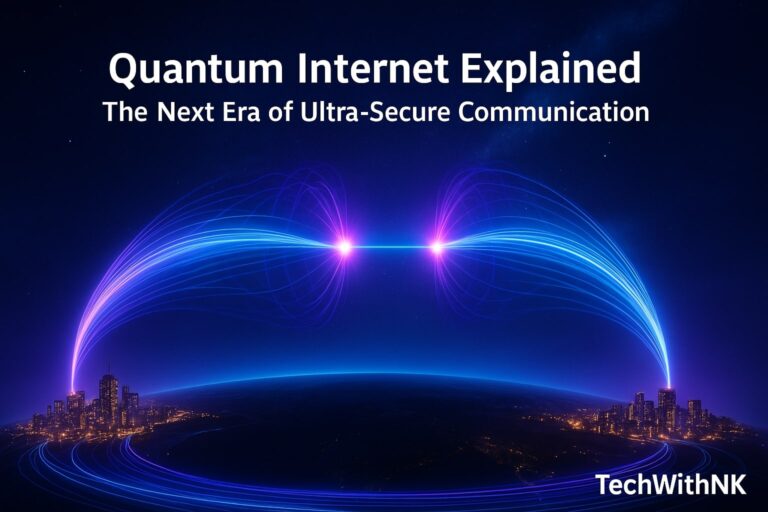🛰️ Introduction: The Next Leap After 5G
The world is still unlocking the full potential of 5G — enabling smart cities, autonomous vehicles, and the Internet of Things (IoT). Yet, the next wave of innovation is already on the horizon — 6G.
Expected to roll out commercially by 2030, 6G promises to go beyond speed — creating a deeply intelligent, immersive, and interconnected digital world where communication happens not just through data and video, but through holograms, extended reality, and AI-driven networks.
While 5G connects everything, 6G aims to make networks think and feel.
Let’s dive into what 6G is, how it works, and how it will transform communication forever.
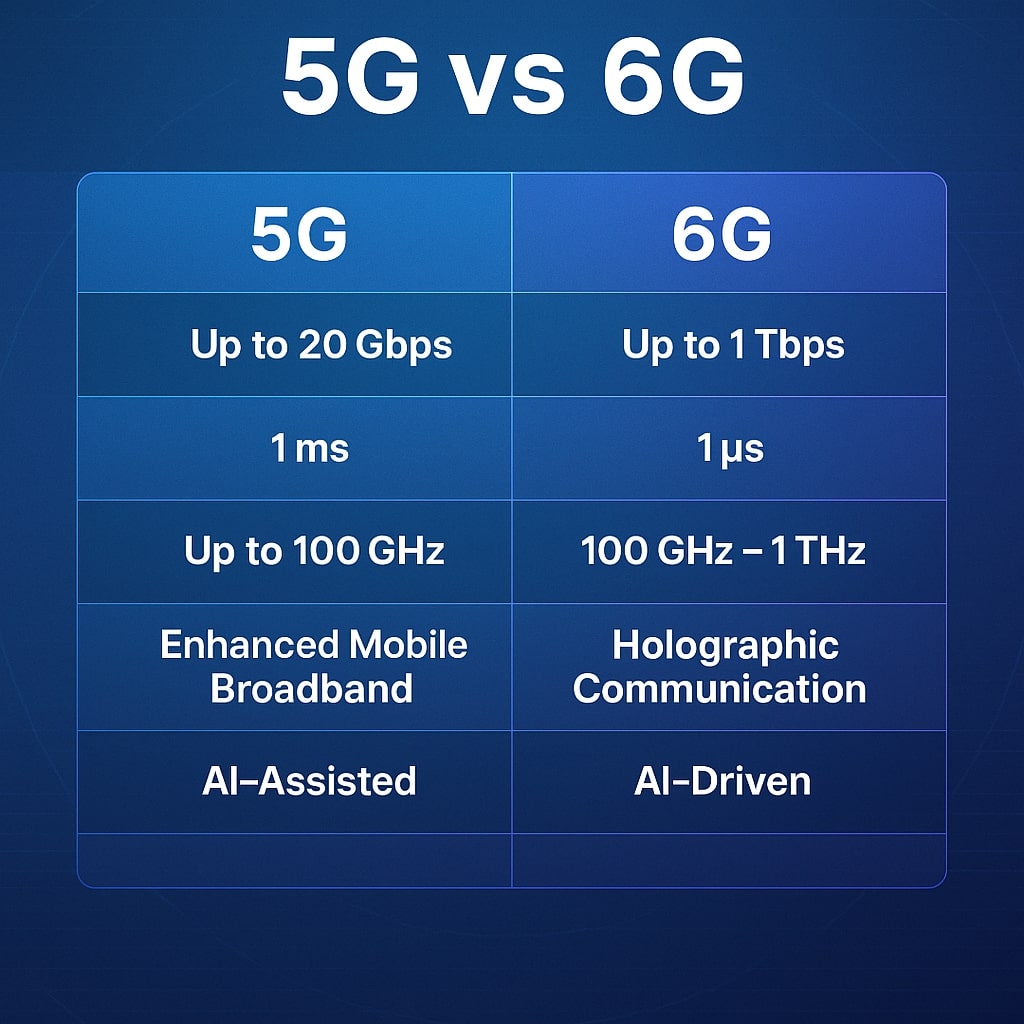
⚡ What is 6G Technology?
6G, or sixth-generation mobile communication, is the successor to 5G, envisioned to offer data rates up to 1 Tbps (terabit per second) and latency as low as 1 microsecond (µs).
It will combine AI, quantum communication, terahertz (THz) frequencies, and real-time sensing to create an intelligent and immersive network infrastructure.
🌐 Key Characteristics of 6G:
| Feature | 5G | 6G |
|---|---|---|
| Peak Data Rate | 20 Gbps | 1 Tbps |
| Latency | 1 ms | 1 µs (microsecond) |
| Frequency Band | up to 100 GHz | 100 GHz – 1 THz |
| Network Intelligence | AI-assisted | AI-driven and self-learning |
| Type of Communication | Machine-type, Human-type | Holographic, XR, Digital Twin |
| Connectivity Density | 1 million/km² | 10 million/km² |
In short: 6G will not just connect devices — it will create a convergence of physical, digital, and biological worlds.
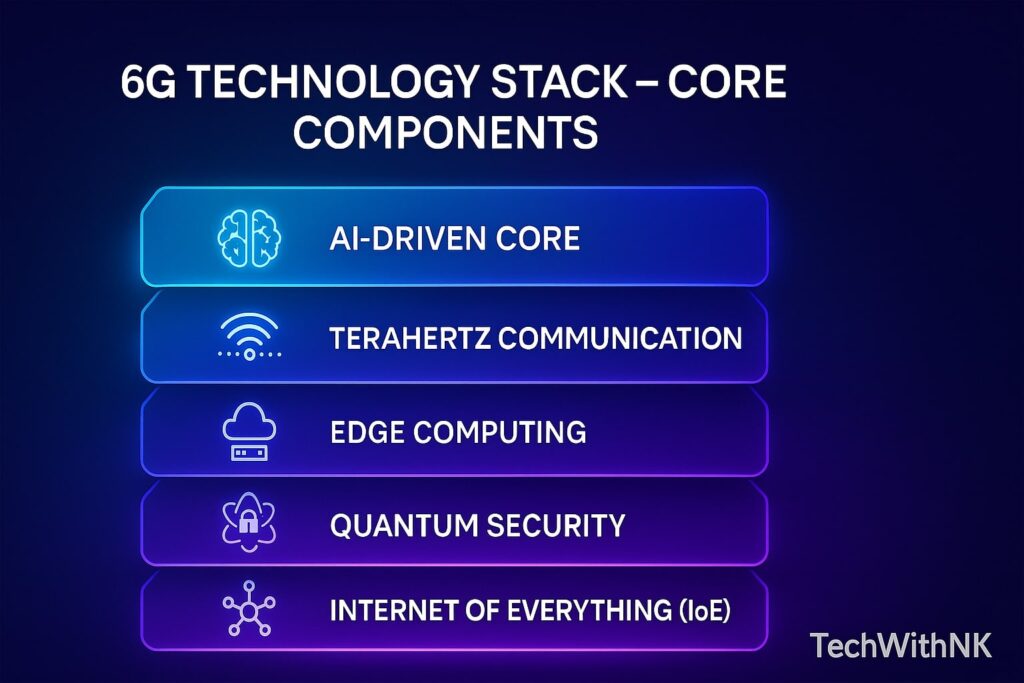
🧠 The AI-Driven 6G Network
One of the biggest revolutions in 6G will be Artificial Intelligence at the network core.
Unlike 5G, which uses AI mainly for optimization and traffic management, 6G networks will be self-organizing, self-healing, and self-evolving.
🤖 1. AI as the Brain of 6G
6G will integrate AI and Machine Learning (ML) into every layer of communication:
Physical Layer: AI will dynamically select frequencies and power levels.
Network Layer: Intelligent routing and adaptive bandwidth management.
Application Layer: Predictive data flow based on user context and behavior.
6G will be an AI-native network, not just AI-assisted.
🧩 2. Federated Learning for Privacy
6G networks will use federated learning — allowing AI to train on distributed data (like smartphones, IoT devices) without sending raw data to central servers.
This ensures data privacy and reduces network congestion.
🧬 3. Semantic Communication
Rather than transmitting entire messages, 6G AI models will send only the “meaning” — reducing bandwidth drastically.
For example, instead of sending full sentences, AI interprets the intent and recreates it on the receiver’s side.
6G won’t just transfer data — it will transfer understanding.
🌈 Holographic Communication: The Future of Real Presence
Imagine attending a meeting in London while your 3D holographic self interacts with others in real-time — no headset required.
That’s holographic communication, one of the most exciting promises of 6G.
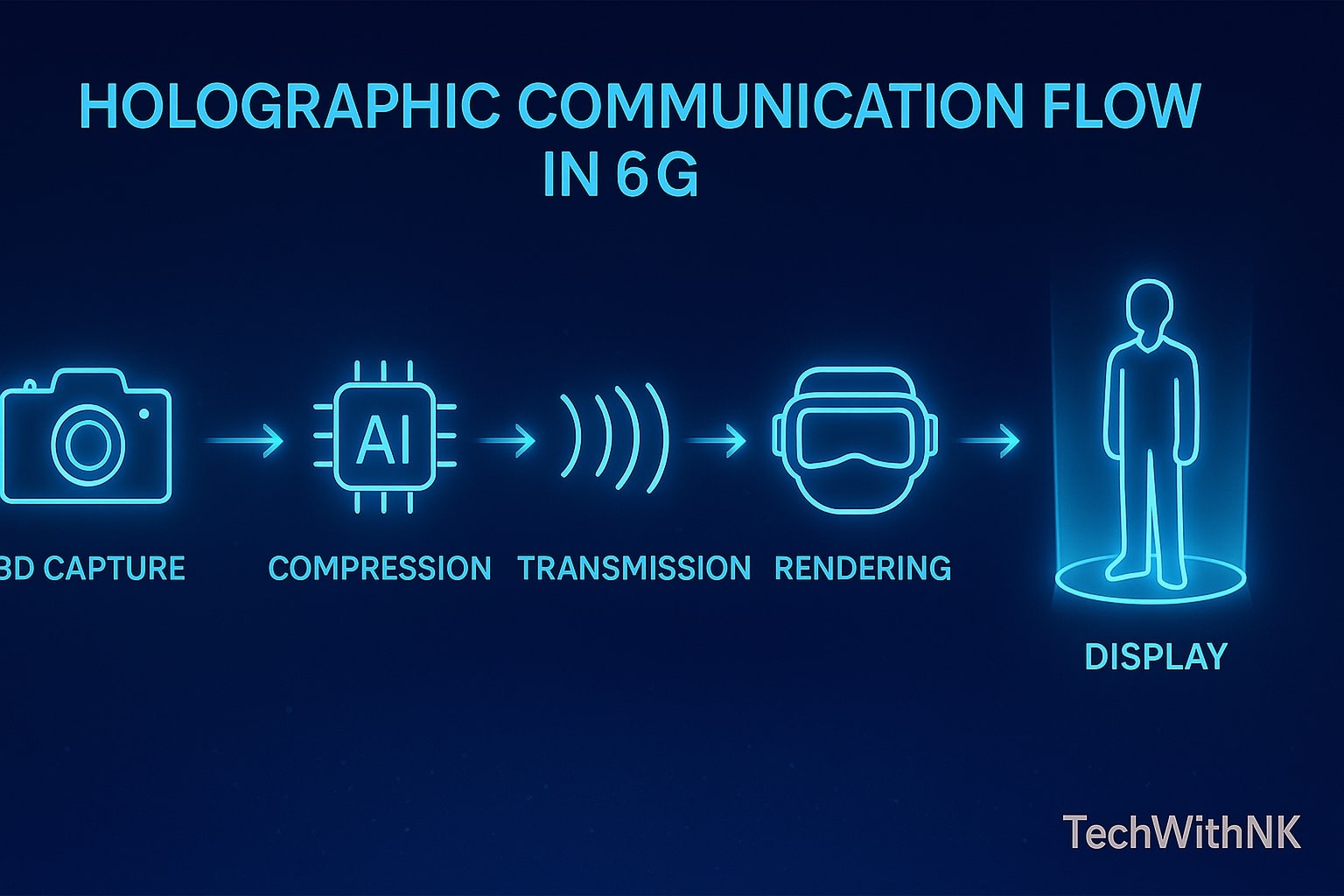
🧍♂️ What is Holographic Communication?
It is the transmission of 3D, life-sized holograms over wireless networks, enabling real presence — you appear as if you are physically there.
To achieve this, the network needs:
Ultra-high bandwidth (hundreds of Gbps per hologram)
Low latency (<1ms)
Precise synchronization
Edge AI for real-time rendering
💡 How It Works:
3D Capture: Multi-angle cameras or LiDAR scan your real-time image.
Compression: AI algorithms compress 3D data using deep learning.
Transmission: Data travels via 6G’s terahertz spectrum.
Rendering: At the receiver’s end, AI reconstructs the hologram on AR/VR or holographic display.
🚀 Real-World Examples (Concepts):
Holographic Calls: 3D virtual meetings with realistic gestures.
Virtual Classrooms: Teachers appearing as holograms worldwide.
Telemedicine: Doctors performing remote diagnostics with holographic patients.
Entertainment: Live concerts where artists appear as holograms globally.
Holographic communication will make “telepresence” truly real — merging physical and digital interaction seamlessly.
🌌 Terahertz Communication: The Backbone of 6G
To reach 1 Tbps speed, 6G will utilize terahertz (THz) frequency bands — ranging from 100 GHz to 1 THz.
These frequencies allow extremely high data rates but have shorter range and higher attenuation, meaning they require new technologies like reconfigurable intelligent surfaces (RIS) and massive MIMO.
⚙️ Key Technologies Enabling THz Communication:
Massive MIMO: Hundreds of antennas for spatial multiplexing.
RIS (Smart Reflectors): Surfaces that guide and shape radio waves.
Beamforming: Directs energy toward the receiver, reducing loss.
Quantum Transceivers: Enable ultra-fast and secure communication.
🧩 6G Core Technologies Overview
| Technology | Description | Role in 6G |
|---|---|---|
| AI & ML | Embedded at all layers | Self-learning networks |
| Terahertz Spectrum | 100 GHz – 1 THz | Ultra-high-speed data |
| Reconfigurable Intelligent Surfaces (RIS) | Smart walls & buildings | Signal reflection & coverage |
| Quantum Communication | Quantum encryption | Unhackable data transfer |
| Edge Computing | Localized processing | Reduces latency |
| Digital Twins | Virtual replica of real systems | Predictive analysis |
| Extended Reality (XR) | AR + VR + MR | Immersive experiences |
| Blockchain Integration | Decentralized control | Data security & identity |
🧬 6G and the Internet of Everything (IoE)
5G connected things; 6G will connect intelligence.
The Internet of Everything (IoE) will go beyond connecting humans and devices — it will connect sensors, machines, vehicles, drones, robots, and even the human body through bio-integrated devices.
🔗 Applications:
Smart cities that predict energy and traffic needs.
AI-powered agriculture with soil and weather sensing.
Remote surgery and tactile Internet.
Autonomous drones and vehicles sharing 3D maps in real-time.
🏙️ 6G in Smart Cities and Infrastructure
🌆 Smart Traffic and Mobility
6G will enable V2X (Vehicle-to-Everything) communication where cars, roads, and traffic signals share data.
This means zero-accident roads and AI-controlled traffic flow.
⚙️ Smart Manufacturing
Factories will use digital twins of machines and production lines to predict failures and optimize efficiency.
🏥 Smart Healthcare
With holographic telepresence and AI sensors, doctors can perform remote diagnostics and robotic surgeries in real time.
🏢 Smart Buildings
Walls embedded with RIS panels will enhance indoor connectivity and energy efficiency.
🔒 Security in 6G: Quantum and Blockchain Integration
🧠 Quantum-Safe Encryption
6G networks will use quantum key distribution (QKD) to prevent hacking.
Even if intercepted, quantum-encrypted data cannot be decoded without disturbing the quantum state.
⛓️ Blockchain for Decentralized Trust
Blockchain will ensure identity verification, data integrity, and transaction trust between billions of devices — without a central authority.
6G = Quantum Security + Blockchain Trust + AI Intelligence.
🛰️ Global Efforts and Research in 6G
🌍 Leading Countries:
South Korea: SK Telecom and Samsung have 6G labs researching terahertz systems.
Japan: NTT DoCoMo and NEC working on holographic communication.
USA: The “Next G Alliance” by ATIS leading 6G roadmap.
Europe: “Hexa-X-II” program developing 6G standards.
India: IIT Madras and DoT working on indigenous 6G R&D.
📅 Timeline:
| Phase | Year | Description |
|---|---|---|
| Research & Concept | 2020–2024 | Fundamental technologies |
| Prototype Development | 2025–2027 | Testing terahertz and AI networks |
| Standardization | 2027–2028 | ITU & 3GPP defining 6G specs |
| Commercial Launch | 2030 | Public rollout begins |
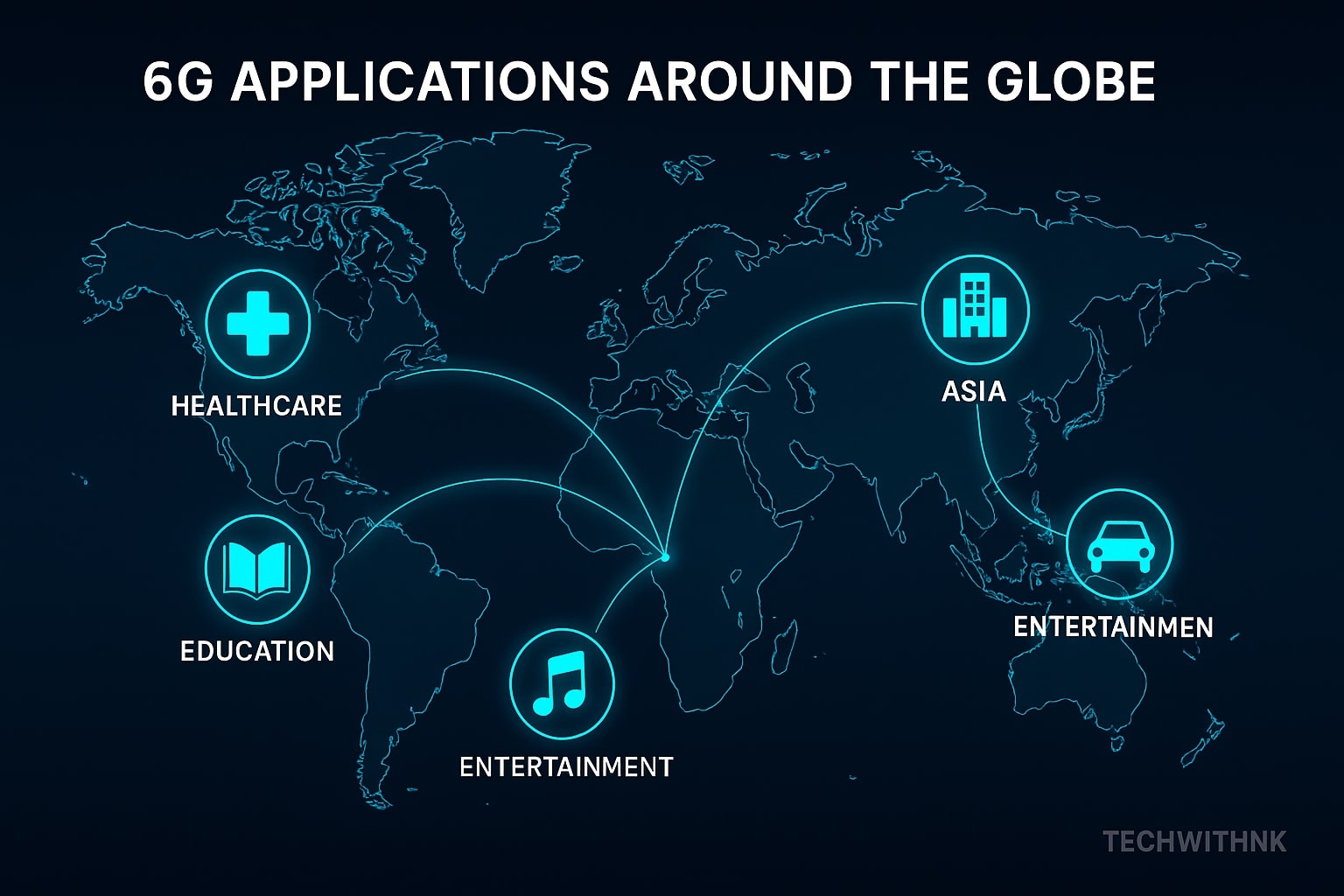
🌐 6G Use Cases: Transforming Every Industry
| Sector | 6G Impact |
|---|---|
| Healthcare | Holographic telepresence, remote surgeries |
| Education | Immersive 3D classrooms, virtual teachers |
| Entertainment | Holographic concerts, AR/VR sports |
| Transportation | Fully autonomous, interconnected vehicles |
| Industry 5.0 | Human–robot collaboration with digital twins |
| Space Communication | Satellite-based 6G for global coverage |
| Defense | Quantum-secure and AI-driven coordination |
| Agriculture | Real-time monitoring with smart sensors |
🔮 The Vision: 6G and the Merging of Realities
6G will create what scientists call the “Internet of Senses.”
This means communication through all five senses — sight, sound, touch, taste, and smell — transmitted digitally via sensory networks.
Imagine:
Feeling the texture of a fabric before buying online.
Smelling food from a restaurant menu hologram.
Experiencing a 3D concert from your living room.
It sounds futuristic — but that’s exactly where 6G is headed.
⚙️ Challenges on the Road to 6G
1. Hardware Limitations
Building affordable THz transceivers and intelligent antennas remains complex.
2. Energy Consumption
Ultra-fast data rates need enormous power — requiring new green communication systems.
3. Standardization
Global coordination for frequency bands, security, and interoperability.
4. Privacy and Ethics
AI-driven networks must be transparent and accountable.
5. Infrastructure Cost
Deploying billions of micro-cells and smart surfaces will need huge investments.
🌍 India’s Journey Toward 6G
India has taken bold steps toward indigenous 6G development.
🇮🇳 Key Highlights:
6G Vision Document (DoT, 2023) sets a goal to launch by 2030.
Bharat 6G Alliance (B6GA) formed to coordinate academia and industry.
ISRO’s satellite internet plans to integrate with future 6G networks.
IIT Madras & IIT Delhi leading 6G testbed research.
India’s vision: “From consumer of 5G to creator of 6G.”
💡 Future Possibilities: When 6G Meets AI and Quantum
6G’s integration with AI, quantum computing, and cloud-edge fusion could lead to technologies like:
Brain-Computer Interfaces (BCI): Direct thought-based control of devices.
Digital Humans: AI avatars that interact like real people.
Quantum Internet: Instantaneous global data transmission.
Sustainable Networks: AI-optimized energy and bandwidth usage.
🌟 Conclusion: The Dawn of Intelligent Connectivity
6G will not just change how fast we connect — it will change why we connect.
From holographic telepresence to AI-powered self-learning networks, 6G represents the fusion of communication and intelligence.
It will enable a reality where humans, machines, and environments communicate seamlessly — in real-time and across dimensions.
As we step toward 2030, 6G is set to become the foundation for the intelligent, immersive, and interconnected world of tomorrow.
✅ Author: TechWithNK
💬 “Exploring the Future of Technology, Science & Innovation”
When will 6G be available?
6G is expected to launch commercially by 2030, with prototypes and testing already underway globally.
How fast will 6G be?
6G aims to deliver up to 1 Tbps speeds — nearly 50× faster than 5G.
How will 6G impact India?
India’s Bharat 6G Alliance aims to build homegrown 6G technology, boosting digital inclusion, rural connectivity, and industrial automation.
